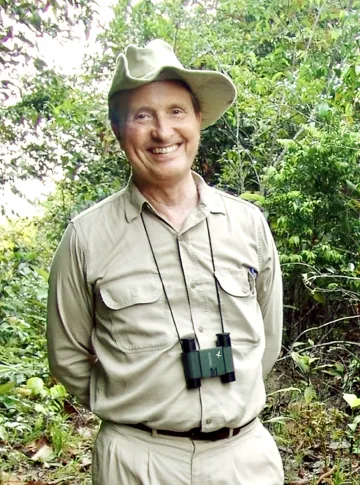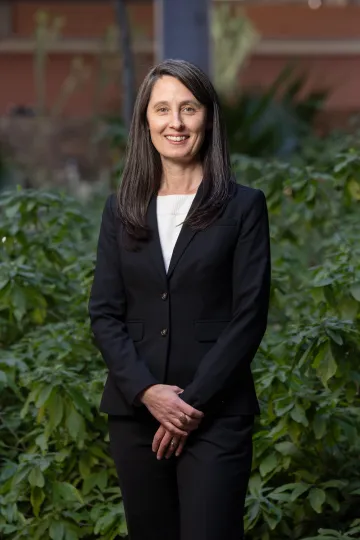Connecting to Conservation
The new Lovejoy Center for Bridging Biodiversity, Conservation Science, and Policy embraces the passion of Thomas Lovejoy.

The University of Arizona’s new Lovejoy Center for Bridging Biodiversity, Conservation Science, and Policy honors Thomas Lovejoy’s legacy.
Photo provided by Betsy Lovejoy
Thomas Lovejoy was a dynamic, Yale-educated ecologist who devoted his life to mentoring young academics and to preserving the Brazilian Amazon. He was brilliant at interpreting science in ways everyone could understand, and he pioneered a holistic, ecosystem-wide approach to conservation that he called “biodiversity.” In 2018, he founded the Thomas Lovejoy Amazon Biodiversity Center in Washington, D.C., advocating for the sustainable use of the forest and training the next generation of conservationists to protect it.
Lovejoy also was an exuberantly social man, renowned for his dinner parties. “He was famous for those gatherings at his dining room table, strategically bringing together different people — scientists, educators, policy makers, influencers, celebrities — to discuss important conservation issues,” says his daughter, Betsy Lovejoy.

Photo provided by Betsy Lovejoy
“It was fun to watch, because he would ask a question and then sit back and let everyone engage. Some of his big ideas came from those dinners he hosted.”
When Thomas Lovejoy passed away in 2021, a colleague described him to The New York Times as a “historic figure.” “He really put the Amazon, and in particular Amazonia, on the international conservation map,” said Russell Mittermeier, chief conservation officer with the environmental group Re:wild.
In the same article, marine ecologist Jane Lubchenco — now deputy director for climate and environment in the White House’s office of science and technology policy — recalled how Lovejoy’s dinner parties always had “an element of a higher purpose. He brought people together to build connections in a way that might lead to more conservation action.”
Thanks to a $5 million gift from the Amazon Biodiversity Center, those connections will continue at the University of Arizona’s new Lovejoy Center for Bridging Biodiversity, Conservation Science, and Policy. The new center, complete with an endowed chair, honors a remarkable man with a seemingly infinite resume. Thomas Lovejoy received his bachelor’s and doctoral degrees from Yale University. He directed the World Wildlife Fund-US program from 1973 to 1987, where he was responsible for its scientific, western hemisphere and tropical forest components.
He also created the popular and long-running PBS series “Nature” and fashioned a process for developing countries to obtain international debt relief in exchange for undertaking conservation projects. In 1987, he was appointed as the Smithsonian Institution’s assistant secretary for environmental and external affairs. From 1989 to 1992, he served on the President’s Council of Advisors in Science and Technology.
Through it all, Lovejoy’s passion for the Brazilian Amazon remained his focus. He was smitten from his very first research project there in 1965; a little more than decade later, he was collaborating with the Smithsonian and with Brazil’s National Institute for Amazon Research to establish the Biological Dynamics of Forest Fragments Project, which would ultimately be supported in part by the Thomas Lovejoy Amazon Biodiversity Center. Its mission included championing the then-new discipline of conservation biology.
“He was at the cusp of talking about biodiversity,” says Betsy Lovejoy. “When he first began formulating that concept, it was not understood at all.” Specifically, his research revealed how a warming planet was impacting diversity in the Amazon region.
“It’s remarkable — and so timely,” she says, “because now when you look at climate change, you realize that he was certainly ahead of his time. He just cared so much about the planet and about doing the right thing to protect it. That was always first and foremost in his mind.” And, Betsy Lovejoy says, he knew that the only way to protect the planet is to educate younger generations.
The new UArizona center aims to carry forward his passion. “The Amazon Biodiversity Center realized that, in order to really secure his legacy and grow it the way he wanted, they would have to find another institution to carry it on,” says Betsy Lovejoy. She describes both centers as “really similar in their mission, specifically the science and research and the fellowships and the global advocacy.”
That was obvious, she says, during her first visit to UArizona, where she met the people who would be involved with the new center. She found the campus dazzling. “There’s just this completely amazing built-in community of really brilliant minds working in diverse disciplines — Earth sciences, political science, social scientists — in a very collaborative and inclusive way,” she says.
“There’s so much strength in that whole collaborative and inclusive culture. And that’s how my dad was. He worked very collaboratively, and he was very inclusive. That was something that was really important to him. It all lines up incredibly beautifully.”

Rachel Gallery was appointed the inaugural holder of the Thomas E. Lovejoy Endowed Chair in Biodiversity, Conservation Science, and Policy and is the center’s founding director.
Photo: Chris Richards
Rachel Gallery is the new center’s endowed chair. An ecologist by training, she shares the same vision for the center, calling Thomas Lovejoy “the most influential science diplomat and conservationist of our time.” And, she continues, “he was also a kind and a generous mentor. He was a dear friend to many people, and he created enormous community. Those are attributes that I want to carry forward through the Lovejoy Center.”
The timing couldn’t be more critical. “We are in a moment where I think more and more people are understanding the value of ‘biodiversity,’ which was a term that Tom helped coin,” Gallery says. “It’s no longer a jargon word that has people saying, ‘What is that, and why should I care?’ I think that we all now have a fundamental understanding of the fact that species matter, not only for their own inherent value but also because people are just one species sharing this planet with the millions of others.”
In a larger sense, she says, “our mission, which is guided by Thomas Lovejoy’s scientific work and legacy, is advancing biodiversity, conservation science, and policy through research fellowships and global collaboration. The way we’re going to enact that mission will evolve, but ... we’re developing this culture of community that not only reflects Tom’s outstanding science and policy contributions but also his humanity, his generosity and his passion for biodiversity.”
That effort includes specific initiatives like a fellows program aimed at creating a global network of scientists, policy experts and communicators, with the goal of creating a community of biodiversity experts. “In five to 10 years’ time, we’re going to have this international network of fellows running biodiversity initiatives across the globe,” Gallery says. “Our initial intent is to focus on fellows from diverse disciplines, diverse identities and diverse geographies. That will ensure we are really putting our resources where they are needed to move towards more equity and inclusion in science.
Along with his passion for conservation, Thomas Lovejoy’s beloved dining room table — scene of his famous dinner parties — is also coming to Tucson, where it will reside in the venerable research station atop Tumamoc Hill.
“Frankly,” says Gallery, “we found the perfect home for it.”

